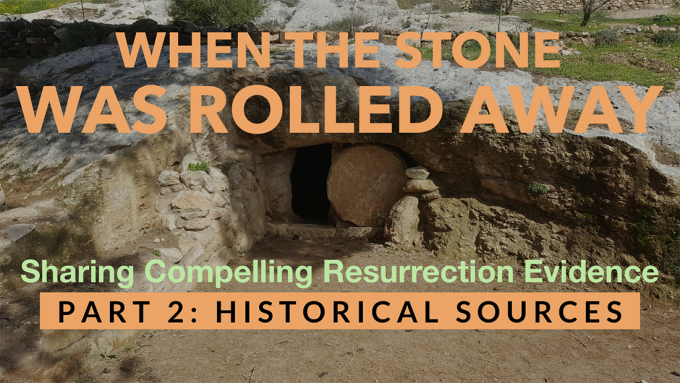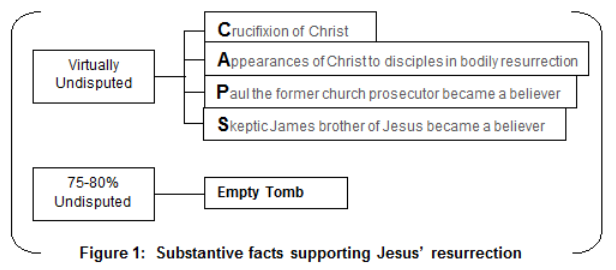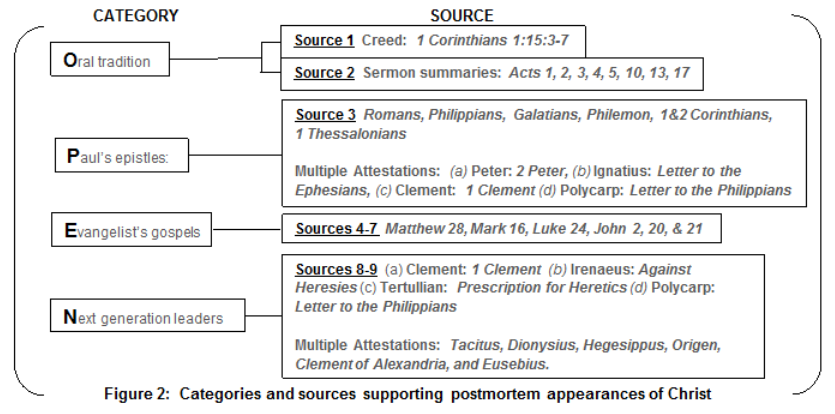For Part 1, please click here.
In Part II we will examine sources germane to the aforementioned historical facts that Jesus was raised.
Category 1, Source 1 In first century Palestine, pen and paper were scarce. 1 Corinthians 15:3-7 is the quintessential text among critical scholars for citing the church’s earliest oral tradition. According to Dr. Habermas, most scholars place the origin of this pre-Pauline creed within five years of Jesus’ crucifixion. Paul says, 3 For what I received I passed on to you as of first importance: that Christ died for our sins according to the Scriptures, 4 that he was buried, that he was raised on the third day according to the Scriptures, 5 and that he appeared to Cephas, and then to the Twelve. 6 After that, he appeared to more than five hundred of the brothers and sisters at the same time, most of whom are still living, though some have fallen asleep. 7 Then he appeared to James, then to all the apostles 1 Corinthians 15:3-7 (NIV). The words “received” and “passed” are Greek terms for passing on tradition. Paul is not the originator of the biblical text, nor did he receive it from the Lord. Paul’s source was other Christians, and he is passing it on.[7]
Category 1, Source 2 is the oral tradition notable in the Book of Acts and reflected in the kerygma (i.e.
Category 2, Source 3 The evidence for
Category 3, Sources 4-7 are the gospel accounts of Matthew, Mark, Luke, and John. Each of these independent sources claims resurrection appearances, or implies the tomb was empty because Christ had been raised: the sources are Matthew 28:9, Matthew 28:13, Mark 16:6, Luke 24:5-6, Luke 24:36-43, John 2:18-22, John 20:1-15, John 20:24-28, and John 21:19-30. While authorship of the gospels is highly disputed, “it is well accepted that all four gospels plus Acts, the sequel to Luke, were written during the first century, within seventy years of Jesus’ resurrection.”[9]
Habermas adds that use of the gospels as a source for resurrection claims is not dependent on the gospel authorship debate. Rather, the larger point hinges on numerous, independent, early, multiply-attested, even non-biblically attested sources making claims to the resurrection. In other words, even if we took the most critical approach possible, and assumed unknown gospel authorship, and that the majority of gospel content is legendary, the fact remains: the gospels are
Category 4, Sources 8-9 come from the next generation leaders, Clement of Rome and Polycarp being in the forefront. Their testimony is
In AD 95, Clement wrote in 1 Clement that the apostles were so certain of the resurrection they proclaimed the Kingdom of God. Around AD 185 Irenaeus in Against Heresies states: “Clement had been conversant with the apostles, and received instructions from them.” Around AD 200, Tertullian writes in Prescription for Heretics, that Clement had been ordained a bishop by Peter.
Polycarp, in his Letter to the Philippians (AD 110 - AD140), mentions Christ’s resurrection five times. Around AD 180, Irenaeus says of Polycarp in Against Heresies, that he was instructed and ordained a bishop by the apostles. In addition, Irenaeus reports that Polycarp received his instruction directly from the eyewitnesses, and had familiar interaction with John, and the other disciples who had seen Christ.[11]
Additionally, we have good historical evidence the apostles and disciples not only “claimed” to see the risen Christ, but “believed” it. The evidence for this claim rests on the assertion that people do not usually suffer and die for something they know to be false. This is contrasted with those who die for a sincere belief, which happens often. The eyewitnesses, not their successors, were in the unique position to know if Christ had been resurrected, making their death all the more improbable if they were purposely lying.[12] These sufferings and deaths and their connection to the risen Christ rests on multiple sources: Clement (AD 95), Polycarp (AD 100), Ignatius (AD 110), Tacitus (AD 64-67), Dionysius (AD 170), Hegesippus (AD 170), Tertullian (AD 200), Origen (AD 200), Clement of Alexandria (AD 200), and Eusebius (AD 230s). Even if all these accounts were riddled with embellishments, the weight of historical evidence points toward the disciple’s suffering, and in some cases dying, for their “sincere belief” that Christ was raised from the dead.[13]
In conclusion, evidence for Jesus’ resurrection has been presented using the minimal facts approach, which considers only data so strongly attested historically that even the majority of non-believing scholars find them acceptable. We considered a quintet of facts: C.A.P.S. plus the Empty Tomb.
Using the acronym O.P.E.N. we have examined nine independent early sources spanning four categories of historical evidence with the focus on Christ’s postmortem appearances. Dr. Habermas summarizes the critical response to this data: “I recently completed an overview of more than 1,400 sources on the resurrection of Jesus published since 1975. I’ve studied and
The academic work of William Lane Craig justifies him as conceivably the premier Christian apologist in the last
Attempts claiming the resurrection has little or no historical support comes from understudied laymen, not critical scholarship. The wealth of historical data does not prove the
If you are interested in pursuing additional depth in defense of the historical claim of the physical resurrection of Jesus and being able to share those truths, a recommended resource is The Case for the Resurrection of Jesus authored by Gary Habermas and Michael Licona.
Footnote References [1] Norman Geisler, Baker Encyclopedia of Christian Apologetics (Grand Rapids: Baker Books, 2000), 665. [2] Gary Habermas and Michael Licona, The Case for the Resurrection of Jesus (Grand Rapids: Kregel Publications, 2004), 47. [3] Ibid, 36-40. [4] Ibid, 48-68. [5] Ibid, 69-74. [6] Ibid, 48-77. [7] Ibid, 51-53. [8] Ibid, 280. [9] Ibid, 53. [10] Ibid, 50-51. [11] Ibid, 54-55. [12] Ibid, 56-57. [13] Ibid, 57-59. [14] Ibid, 60. [15] William Lane Craig, Reasonable Faith Christian Truth and Apologetics (Wheaton: Crossway, 2008), 361.





